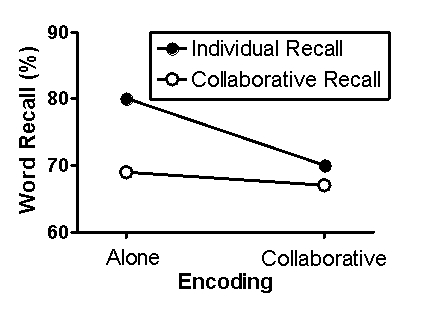Use the following to answer questions :
Scenario I
The scenario is based on and presents fabricated data consistent with the following study:
Barber,S.J. ,Rajaram,S. ,& Fox,E.B.(2012) .Learning and remembering with others: The key role of retrieval in shaping group recall and collective memory.Social Cognition,30(1) ,121-132.doi:10.1521/soco.2012.30.1.121
In a typical experiment on collaborative memory,participants first encode information individually and later attempt to recall the information either individually or in a small group (collaboratively) .While the recall of the collaborative group is better than that of any individual,the summed recall of individuals typically is better than the recall of the collaborative group.This is a phenomenon termed collaborative inhibition.Barber,Rajaram,and Fox (2012) investigated this phenomenon during both the encoding and retrieval stages of memory.
Participants created sentences out of a word bank,which provided for the opportunity to encode this information.After completing this task,participants engaged in an unrelated task-solving mazes-for 10 minutes.Then,in a surprise memory test,they were asked to recall as many words from the word bank as possible (retrieval) .
Participants were randomly assigned to one of four groups.In the first group (Alone-Alone) ,participants were studied individually during both the encoding and retrieval phases of the experiment.In the second group (Alone-Collaborative) ,participants were studied individually during the encoding phase and as part of a three-member team (triad) during the retrieval phase.In the third group (Collaborative-Alone) ,participants were studied in a triad during the encoding phase but individually during the retrieval phase.Finally,in the fourth group (Collaborative-Collaborative) ,participants completed both phases of the experiment as part of a triad.
Fabricated results illustrating the major finding of Barber et al.(2012) are presented in Figure 6.1.This figure shows the percentage of words from the word bank accurately recalled as a function of group.For the two groups that experienced the retrieval phase individually,scores represent the summed retrieval of the individuals comprising the group.For the two groups that experienced the retrieval phase as part of a triad,scores simply represent the collaborative performance.
Figure 6.1 
-(Scenario I) Some degree of collaborative inhibition was observed:
Definitions:
Primary Aux View
Refers to the primary auxiliary view, a secondary viewpoint generated in technical drawings to show features not visible or clear in the principal views.
True-Length Line
A line in a drawing that accurately represents the actual size and length of an object in the specified view.
Hard Line
Strong, distinct lines used in drawing to represent solid edges, boundaries, or significant features of an object.
Break Line
A line used in drafting and design to interrupt and thereby shorten parts of drawings, indicating that the part continues beyond what is shown.
Q10: Six-year-old Jake awakened from stage 4 sleep
Q20: Dopamine is secreted in the pleasure centres
Q81: Recent research has indicated that the two
Q134: Jimmy has a recurring dream about trying
Q208: Research has indicated that,50 years after graduation,people
Q279: When he began drinking alcohol,Patrick would drink
Q390: According to Freud,the latent content of our
Q399: Disapproving of her friend Amy's fiancé,Mindy told
Q432: Much of what we know about the
Q439: The more often a person eats a